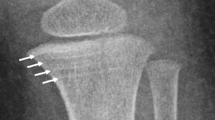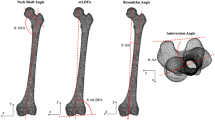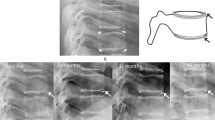Abstract
Background
Growth recovery lines are radiodense lines in long bones reported to be indicators of stress.
Objective
The purpose of this study was to understand the distribution, quantity and associations of growth recovery lines in children ages 0–24 months with high and low risk for child maltreatment.
Materials and methods
We conducted a retrospective cohort study of children ages 0–24 months who had skeletal surveys and an assessment for maltreatment. Growth recovery lines, fractures and osteopenia were assessed independently by two pediatric radiologists blinded to the abuse likelihood.
Results
Of the 135 children in this study, 58 were in the low-risk group, 26 were in the neglect group, and 51 were in the physical abuse group. Children in the neglected and physically abused groups had 1.73 times (95% confidence interval [CI] of 1.16, 2.59), P=0.007) and 1.84 times (95% CI 1.28, 2.63, P<0.001) more growth recovery lines than the low-risk group, respectively. Growth recovery lines occurred at an earlier age in the neglect group (age interaction P=0.03) and abuse group (age interaction P=0.01) compared to the low-risk group. The specificity for maltreatment in children with at least 10 growth recovery lines in the long bones was greater than 84%, while sensitivity was less than 35%. The most common locations for growth recovery lines were distal radius, proximal tibia and distal tibia.
Conclusion
In the absence of a known major stressor, physical abuse and neglect should be considered in children younger than 24 months with at least 10 growth recovery lines.





Similar content being viewed by others
References
Geber J (2014) Skeletal manifestations of stress in child victims of the great Irish famine (1845–1852): prevalence of enamel hypoplasia, Harris lines, and growth retardation. Am J Phys Anthropol 155:149–161
Maat GJ (1984) Dating and rating of Harris's lines. Am J Phys Anthropol 63:291–299
McHenry H (1968) Transverse lines in long bones of prehistoric California Indians. Am J Phys Anthropol 29:1–17
Acheson RM (1959) Effects of starvation, septicaemia and chronic illness on the growth cartilage plate and metaphysis of the immature rat. J Anat 93:123–130
Kennedy JW, Irwin GJ, Huntley JS (2014) Growth arrest lines and intra-epiphyseal silhouettes: a case series. BMC Res Notes 7:27
Park EA (1964) The imprinting of nutritional disturbances on the growing bone. Pediatrics 33:815–862
Teele RL, Abbott GD, Mogridge N, Teele DW (1999) Femoral growth lines: bony birthmarks in infants. AJR Am J Roentgenol 173:719–722
Alfonso-Durruty MP (2011) Experimental assessment of nutrition and bone growth's velocity effects on Harris lines formation. Am J Phys Anthropol 145:169–180
Papageorgopoulou C, Suter SK, Ruhli FJ, Siegmund F (2011) Harris lines revisited: prevalence, comorbidities, and possible etiologies. Am J Hum Biol 23:381–391
Hernandez RJ, Poznanski AK, Hopwood NJ, Kelch RP (1978) Incidence of growth lines in psychosocial dwarfs and idiopathic hypopituitarism. AJR Am J Roentgenol 131(3)
Zapala MA, Tsai A, Kleinman PK (2016) Growth recovery lines are more common in infants at high vs. low risk for abuse. Pediatr Radiol 46:1275–1281
Garn SM, Silverman FN, Hertzog KP, Rohmann CG (1968) Lines and bands of increased density. Their implication to growth and development. Med Radiogr Photogr 44:58–89
Ogden JA (1984) Growth slowdown and arrest lines. J Pediatr Orthop 4:409–415
Hughes C, Heylings DJ, Power C (1996) Transverse (Harris) lines in Irish archaeological remains. Am J Phys Anthropol 101:115–131
American Academy of Pediatrics Section on Radiology (2009) Diagnostic imaging of child abuse. Pediatrics 123:1430–1435
American College of Radiology (2016) ACR–SPR practice parameter for the performance and interpretation of skeletal surveys in children. https://www.acr.org/-/media/ACR/Files/Practice-Parameters/Skeletal-Survey.pdf. Accessed 30 March 2018
Scott AB, Hoppa RD (2015) A re-evaluation of the impact of radiographic orientation on the identification and interpretation of Harris lines. Am J Phys Anthropol 156:141–147
Mays S (1995) The relationship between Harris lines and other aspects of skeletal development in adults and juveniles. J Archaeol Sci 22:10
Gelfond J, Goros M, Hernandez B, Bokov A (2018) A system for an accountable data analysis process in R. R J 10:6–21
Klein GL (2015) The effect of glucocorticoids on bone and muscle. Osteoporos Sarcopenia 1:39–45
Grolleau-Raoux JL, Crubezy E, Rouge D et al (1997) Harris lines: a study of age-associated bias in counting and interpretation. Am J Phys Anthropol 103:209–217
Duffy SO, Squires J, Fromkin JB, Berger RP (2011) Use of skeletal surveys to evaluate for physical abuse: analysis of 703 consecutive skeletal surveys. Pediatrics 127:e47–e52
Jenny C, Hymel KP, Ritzen A et al (1999) Analysis of missed cases of abusive head trauma. JAMA 281:621–626
King WK, Kiesel EL, Simon HK (2006) Child abuse fatalities: are we missing opportunities for intervention? Pediatr Emerg Care 22:211–214
Oral R, Yagmur F, Nashelsky M et al (2008) Fatal abusive head trauma cases: consequence of medical staff missing milder forms of physical abuse. Pediatr Emerg Care 24:816–821
Ravichandiran N, Schuh S, Bejuk M et al (2010) Delayed identification of pediatric abuse-related fractures. Pediatrics 125:60–66
Jackson G (1972) Child abuse syndrome: the cases we miss. Br Med J 2:756–757
Acknowledgments
The authors thank Qianqian Liu, who performed statistical programming and generated tables and graphics for this manuscript. The authors thank Robert Geller, who programmed the data collection tool in REDCap.
Author information
Authors and Affiliations
Corresponding author
Ethics declarations
Conflicts of interest
None
Additional information
Publisher’s note
Springer Nature remains neutral with regard to jurisdictional claims in published maps and institutional affiliations.
Rights and permissions
About this article
Cite this article
Spiller, L.R., Kellogg, N.D., Mercado-Deane, MG. et al. Growth recovery lines: a specific indicator of child abuse and neglect?. Pediatr Radiol 50, 207–215 (2020). https://doi.org/10.1007/s00247-019-04526-x
Received:
Revised:
Accepted:
Published:
Issue Date:
DOI: https://doi.org/10.1007/s00247-019-04526-x




